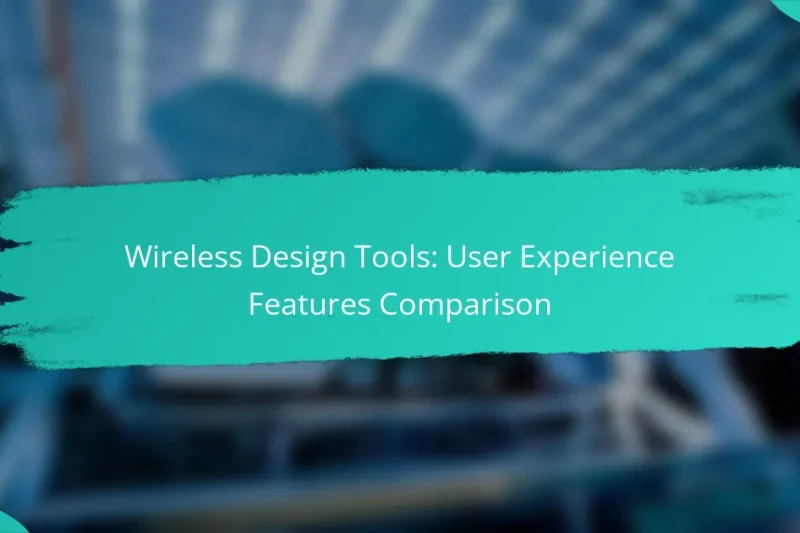In the realm of wireless design, selecting the right tool is crucial for optimizing user experience. … Wireless Design Tools: User Experience Features ComparisonRead more
User Experience in Wireless Design Software
User experience plays a crucial role in the effectiveness of wireless design software, as it directly impacts how users interact with the tools at their disposal. By focusing on intuitive design, efficient workflows, and comprehensive support, software developers can create an environment that enhances productivity and reduces errors. Tools like Altium Designer, Cadence OrCAD, and ANSYS HFSS exemplify how specialized functionalities can cater to the unique needs of wireless engineers, ultimately leading to improved design accuracy and efficiency.
User Feedback: Enhancing Usability in Wireless Design Software
User feedback plays a crucial role in enhancing the usability of wireless design software by offering … User Feedback: Enhancing Usability in Wireless Design SoftwareRead more
User Experience Trends: Wireless Design Software for Enterprises
In the evolving landscape of enterprise technology, wireless design software has become essential for optimizing network … User Experience Trends: Wireless Design Software for EnterprisesRead more
User Experience Metrics: Evaluation for Wireless Design Software
User experience metrics are essential for evaluating wireless design software, as they reveal how well users … User Experience Metrics: Evaluation for Wireless Design SoftwareRead more
User Experience: Adoption Rates, Impact and Trends
User experience (UX) is becoming increasingly vital for businesses in Australia, with adoption rates rising as … User Experience: Adoption Rates, Impact and TrendsRead more
User Experience Best Practices: Small Business Wireless Design Software
For small businesses in Australia, selecting the right wireless design software is crucial for optimizing user … User Experience Best Practices: Small Business Wireless Design SoftwareRead more
Choosing Wireless Design Software: User Experience Ratings
Choosing the right wireless design software is crucial for achieving efficient and effective design outcomes. In … Choosing Wireless Design Software: User Experience RatingsRead more
What are the best practices for user experience in wireless design software?
The best practices for user experience in wireless design software focus on creating an intuitive, efficient, and supportive environment for users. Prioritizing usability, effective onboarding, and ongoing support can significantly enhance the overall experience.
Intuitive interface design
An intuitive interface design is crucial for wireless design software, as it allows users to navigate the application easily. Key elements include clear labeling, logical organization of features, and minimal clutter. Consider using familiar design patterns that align with user expectations to enhance usability.
Employing a clean layout with consistent color schemes and typography can also improve user engagement. Regular user testing can help identify pain points and areas for improvement in the interface.
Responsive customer support
Responsive customer support is essential for maintaining a positive user experience in wireless design software. Users should have access to multiple support channels, such as live chat, email, and phone support, to address their queries promptly. Aim for response times within a few hours for email and chat inquiries.
Additionally, providing a dedicated support team that understands the software’s intricacies can help users resolve issues more effectively. Regularly gathering feedback on support interactions can guide improvements in service quality.
Effective user onboarding
Effective user onboarding is vital for helping new users acclimate to wireless design software. A well-structured onboarding process should include guided tutorials, interactive walkthroughs, and practical exercises that demonstrate key features. Aim to keep onboarding sessions under 30 minutes to maintain user engagement.
Consider offering personalized onboarding experiences based on user roles or specific use cases, which can enhance relevance and retention. Follow-up communications after onboarding can reinforce learning and encourage users to explore advanced features.
Consistent updates and improvements
Consistent updates and improvements are necessary to keep wireless design software relevant and user-friendly. Regularly releasing updates that address bugs, enhance performance, and introduce new features can significantly improve user satisfaction. Aim for quarterly updates to keep the software fresh and aligned with user needs.
Communicating these updates clearly to users, including what has changed and how it benefits them, can foster a sense of community and trust. Encourage user feedback on updates to ensure that future improvements align with their expectations.
Comprehensive documentation
Comprehensive documentation is a cornerstone of user experience in wireless design software. Users should have access to clear, detailed guides, FAQs, and troubleshooting resources that cover all aspects of the software. Organizing documentation into easily navigable sections can help users find information quickly.
Consider including video tutorials and step-by-step instructions to cater to different learning styles. Regularly updating documentation to reflect software changes ensures users have the most accurate information at their fingertips.
How does user experience impact wireless design software performance?
User experience significantly influences the performance of wireless design software by affecting how efficiently users can navigate and utilize the tools available. A well-designed interface can lead to quicker task completion and fewer errors, ultimately enhancing overall productivity.
Increased user satisfaction
When wireless design software is user-friendly, it leads to higher satisfaction among users. Intuitive interfaces and responsive designs allow users to accomplish tasks with minimal frustration, fostering a positive experience. This satisfaction can translate into a preference for specific software solutions over competitors.
For instance, features such as customizable dashboards and easy access to frequently used tools can greatly enhance user enjoyment and engagement with the software.
Higher retention rates
Improving user experience can lead to higher retention rates for wireless design software. Users are more likely to continue using software that meets their needs efficiently and effectively. A seamless experience reduces the likelihood of users seeking alternatives, which can be costly for software providers.
Offering regular updates based on user feedback can further enhance retention, as it shows a commitment to improving the user experience and addressing pain points.
Improved design efficiency
A positive user experience directly contributes to improved design efficiency in wireless software. When users can easily navigate the software, they spend less time on learning curves and more time on actual design work. This efficiency can lead to faster project completion and better resource allocation.
Incorporating features like drag-and-drop functionality or real-time collaboration tools can streamline workflows, making it easier for teams to work together effectively and reducing the time spent on revisions.
What tools enhance user experience in wireless design software?
Several tools significantly improve user experience in wireless design software by offering intuitive interfaces, robust features, and efficient workflows. Key software like Altium Designer, Cadence OrCAD, and ANSYS HFSS provide specialized functionalities that cater to the needs of wireless engineers, enhancing productivity and design accuracy.
Altium Designer
Altium Designer is known for its user-friendly interface and powerful design capabilities, making it a popular choice among wireless engineers. It integrates schematic capture, PCB layout, and component management in a single platform, which streamlines the design process.
One of its standout features is the real-time collaboration tool, allowing multiple users to work on a project simultaneously. This can significantly reduce design time and improve communication among team members.
Cadence OrCAD
Cadence OrCAD offers a comprehensive suite of tools tailored for wireless design, including simulation, PCB layout, and signal integrity analysis. Its robust simulation capabilities enable engineers to predict performance issues early in the design phase, which can save time and costs later on.
Additionally, OrCAD’s integration with Allegro provides advanced routing and layout options, essential for complex wireless designs. Users should consider the learning curve associated with its extensive features, which may require additional training for new users.
ANSYS HFSS
ANSYS HFSS is a leading software for high-frequency electromagnetic field simulation, crucial for wireless design. It allows engineers to analyze and optimize antenna performance and other RF components with high accuracy.
HFSS provides a variety of simulation options, including 3D modeling and parametric analysis, which can help in fine-tuning designs for optimal performance. Users should be aware that while HFSS offers powerful capabilities, it may require significant computational resources and expertise to fully leverage its potential.
What criteria should be considered when selecting wireless design software?
When selecting wireless design software, consider usability, integration with existing tools, and cost. These criteria will help ensure that the software meets your project needs and fits seamlessly into your workflow.
Usability and learning curve
Usability is crucial for effective wireless design software. Look for intuitive interfaces that allow users to navigate easily and perform tasks without extensive training. A steep learning curve can hinder productivity, so opt for software that offers tutorials or user-friendly documentation.
Evaluate the software through trials or demos to assess how quickly team members can become proficient. A good rule of thumb is to choose software that requires minimal setup and allows users to start designing within a few hours.
Integration with existing tools
Integration capabilities are essential for ensuring that the wireless design software works well with your current tools. Check if the software can easily connect with simulation tools, project management applications, and other relevant software you already use.
Compatibility can save time and reduce errors, so prioritize solutions that support common file formats and APIs. A seamless integration can enhance collaboration and streamline the design process, making it more efficient.
Cost and licensing options
Cost is a significant factor when selecting wireless design software. Prices can vary widely, so consider your budget and the specific features you need. Look for options that provide a good balance between functionality and price, ensuring you get value for your investment.
Examine licensing models, such as subscription-based or one-time purchase options. Subscription models may offer lower upfront costs but can add up over time, while one-time purchases may require a larger initial investment. Evaluate which model aligns best with your financial strategy and project duration.
What are common challenges in user experience for wireless design software?
Common challenges in user experience for wireless design software include complex interfaces, steep learning curves, and inadequate support for collaboration. These issues can hinder user efficiency and satisfaction, making it essential for developers to prioritize usability and intuitive design.
Complexity of User Interfaces
Many wireless design software applications feature intricate user interfaces that can overwhelm users, especially those new to the field. A cluttered layout or excessive options can lead to confusion and frustration. Simplifying the interface by prioritizing essential tools and providing customizable views can enhance usability.
Consider implementing a dashboard that highlights frequently used features while allowing users to access advanced options as needed. This approach can help streamline workflows and improve overall user experience.
Steep Learning Curves
Wireless design software often requires users to learn specialized terminology and processes, which can create a steep learning curve. To mitigate this, developers should offer comprehensive tutorials, tooltips, and user guides that facilitate onboarding and skill development.
Incorporating interactive tutorials or guided workflows can significantly reduce the time it takes for users to become proficient. Providing a community forum or support network can also help users share knowledge and troubleshoot common issues.
Collaboration Challenges
Effective collaboration is crucial in wireless design projects, yet many software solutions lack robust features for team communication and project sharing. This can lead to miscommunication and delays in project timelines. To address this, software should include real-time collaboration tools and version control systems.
Consider integrating cloud-based features that allow multiple users to work on a project simultaneously, along with clear version tracking. This can enhance teamwork and ensure that all stakeholders are aligned throughout the design process.






